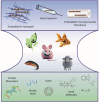Single-Walled Carbon Nanotubes as Optical Transducers for Nanobiosensors In Vivo
- PMID: 39696968
- PMCID: PMC11697343
- DOI: 10.1021/acsnano.4c13076
Single-Walled Carbon Nanotubes as Optical Transducers for Nanobiosensors In Vivo
Abstract
Semiconducting single-walled carbon nanotubes (SWCNTs) may serve as signal transducers for nanobiosensors. Recent studies have developed innovative methods of engineering molecularly specific sensors, while others have devised methods of deploying such sensors within live animals and plants. These advances may potentiate the use of implantable, noninvasive biosensors for continuous drug, disease, and contaminant monitoring based on the optical properties of single-walled carbon nanotubes (SWCNTs). Such tools have substantial potential to improve disease diagnostics, prognosis, drug safety, therapeutic response, and patient compliance. Outside of clinical applications, such sensors also have substantial potential in environmental monitoring or as research tools in the lab. However, substantial work remains to be done to realize these goals through further advances in materials science and engineering. Here, we review the current landscape of quantitative SWCNT-based optical biosensors that have been deployed in living plants and animals. Specifically, we focused this review on methods that have been developed to deploy SWCNT-based sensors in vivo as well as analytes that have been detected by SWCNTs in vivo. Finally, we evaluated potential future directions to take advantage of the promise outlined here toward field-deployable or implantable use in patients.
Keywords: SWCNT; biosensor; implants; in planta; in vivo; mice; nanosensor; near-infrared fluorescence; point-of-care.
Conflict of interest statement
The authors declare no competing financial interest.
Figures





Similar articles
-
Single-walled carbon nanotubes as near-infrared optical biosensors for life sciences and biomedicine.Biotechnol J. 2015 Mar;10(3):447-59. doi: 10.1002/biot.201400168. Epub 2015 Feb 13. Biotechnol J. 2015. PMID: 25676253 Review.
-
Recent advances on applications of single-walled carbon nanotubes as cutting-edge optical nanosensors for biosensing technologies.Nanoscale. 2024 Sep 12;16(35):16344-16375. doi: 10.1039/d4nr01892c. Nanoscale. 2024. PMID: 39157856 Review.
-
Biosensing with Fluorescent Carbon Nanotubes.Angew Chem Int Ed Engl. 2022 Apr 25;61(18):e202112372. doi: 10.1002/anie.202112372. Epub 2022 Mar 1. Angew Chem Int Ed Engl. 2022. PMID: 34978752 Free PMC article. Review.
-
Fluorescent Single-Walled Carbon Nanotubes for Protein Detection.Sensors (Basel). 2019 Dec 7;19(24):5403. doi: 10.3390/s19245403. Sensors (Basel). 2019. PMID: 31817932 Free PMC article. Review.
-
Carbon nanotubes as optical biomedical sensors.Adv Drug Deliv Rev. 2013 Dec;65(15):1933-50. doi: 10.1016/j.addr.2013.07.015. Epub 2013 Jul 29. Adv Drug Deliv Rev. 2013. PMID: 23906934 Review.
Cited by
-
Single-Walled Carbon Nanotube Probes for Protease Characterization Directly in Cell-Free Expression Reactions.bioRxiv [Preprint]. 2025 Jan 14:2025.01.11.632549. doi: 10.1101/2025.01.11.632549. bioRxiv. 2025. Update in: Anal Chem. 2025 May 27;97(20):10745-10754. doi: 10.1021/acs.analchem.5c00883. PMID: 39868320 Free PMC article. Updated. Preprint.
-
Functionalized Carbon Nanotubes: Emerging Nanomaterials for Enhanced Cancer Diagnosis and Imaging.Molecules. 2025 May 29;30(11):2364. doi: 10.3390/molecules30112364. Molecules. 2025. PMID: 40509251 Free PMC article. Review.
-
Near-Infrared Fluorescent Single-Walled Carbon Nanotubes for Biosensing.Small. 2025 Jul;21(26):e2502542. doi: 10.1002/smll.202502542. Epub 2025 May 2. Small. 2025. PMID: 40317978 Free PMC article. Review.
-
Inorganic and hybrid nanomaterials for NIR-II fluorescence imaging-guided therapy of Glioblastoma and perspectives.Theranostics. 2025 Apr 21;15(12):5616-5665. doi: 10.7150/thno.112204. eCollection 2025. Theranostics. 2025. PMID: 40365286 Free PMC article. Review.
-
Applications of Carbon-Based Multivariable Chemical Sensors for Analyte Recognition.Nanomicro Lett. 2025 May 3;17(1):246. doi: 10.1007/s40820-025-01741-0. Nanomicro Lett. 2025. PMID: 40316837 Free PMC article. Review.
References
Publication types
MeSH terms
Substances
Grants and funding
LinkOut - more resources
Full Text Sources
Miscellaneous

